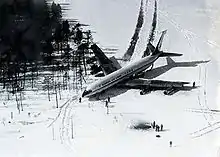Korean Air Lines Flight 902
Korean Air Lines Flight 902 (KAL 902) was a scheduled Korean Air Lines flight from Paris to Seoul via Anchorage. On 20 April 1978, the Soviet air defense shot down the aircraft serving the flight, a Boeing 707, near Murmansk, Soviet Union, after the aircraft violated Soviet airspace.[2][3]
 The plane after landing in the Soviet Union, with visible damage to its left wing | |
| Shootdown | |
|---|---|
| Date | 20 April 1978 |
| Summary | Shot down by Soviet Union[1] |
| Site | near Loukhi, Karelian ASSR, Russian SFSR, Soviet Union 66°02.893′N 33°04.321′E |
| Aircraft | |
| Aircraft type | Boeing 707-321B |
| Operator | Korean Air Lines |
| Registration | HL7429 |
| Flight origin | Orly Airport Paris, France |
| Stopover | Anchorage International Airport Anchorage, Alaska United States |
| Destination | Kimpo International Airport Seoul, South Korea |
| Occupants | 109 |
| Passengers | 97 |
| Crew | 12 |
| Fatalities | 2 |
| Survivors | 107 |
Flight 902 had veered off course over the Arctic Ocean and entered Soviet airspace near the Kola Peninsula, whereupon it was intercepted and fired upon by a Soviet fighter jet. The incident killed two of the 109 passengers and crew members aboard and forced the plane to make an emergency landing on the frozen Korpijärvi lake near the Finnish border.[4]
Events

Flight 902 departed from Paris, France, at 13:39 local time on a course to Seoul, South Korea.[5] The plane's only scheduled stop was in Anchorage, Alaska, US, where it would refuel and proceed to Seoul, avoiding Soviet airspace.[5] It was commanded by Captain Kim Chang Kyu, with Co-pilot Cha Soon Do and Flight Engineer Lee Khun Shik making up the other flight deck crew.[6][7] The aircraft made regular radio check-ins as it flew northwest, the last of which, five hours and twenty one minutes after takeoff, placed it near CFS Alert on Ellesmere Island.[5] The aircraft's flight path took it almost directly over the North Magnetic Pole, causing large errors in the aircraft's magnetic compass-based navigation systems. Its course then turned to the southeast and it flew over the Barents Sea and into Soviet airspace, reaching the Soviet coast an estimated three hours and 1,500 miles (2,400 km) after its southward turn.[5]
Soviet air defence
Soviet air defence radar spotted the plane at 20:54, when the plane was approximately 400 kilometres (250 mi) away from Soviet territorial waters.[8] At 21:19 the plane entered Soviet airspace. As the plane did not respond to multiple requests from the ground, a Su-15 interceptor, piloted by Alexander Bosov, was dispatched to intercept the airliner. Having approached KAL902, Bosov waggled the Su-15's wings multiple times, using the international signal for the airliner to follow the interceptor. Instead KAL902 made a 90 degree turn towards the Soviet-Finnish border. Bosov reported the attempted escape from Soviet airspace to the Air Defence Command Officer Vladimir Tsarkov, and the latter, based on internal instructions, commanded Bosov to shoot down KAL902.
According to Kim's account of the attack, the interceptor approached his aircraft from the right side rather than the left as required by International Civil Aviation Organization (ICAO) regulation.[8] Kim decreased his speed and turned on the navigation lights, indicating that he was ready to follow the Soviet fighter for landing.[8]
According to Soviet reports, the airliner repeatedly ignored commands to follow the interceptor.[9] Flight 902's co-pilot, S.D. Cha, said that the crew had attempted to communicate with the interceptor via radio, but did not receive a response.[6]
Bosov tried to convince his superiors that the plane was not a military threat, but after receiving orders to shoot it down[10][8] at 21:42 he fired an R-60 missile. The missile flew past the target.[8] The second one hit the left wing, knocking off approximately 4 metres (13 ft) of its length. The missile also punctured the fuselage, causing rapid decompression and jamming one of the plane's four turbines.[8] Korean passenger Bahng Tais Hwang died in the missile strike, which wounded several others.[6]
After being hit, the airliner quickly descended from an altitude of 9,000 m (30,000 ft).[8] It fell into a cloud, disappearing from Soviet air defence radars. Soviets mistook the part of the wing that had fallen off Flight 902 for a cruise missile and dispatched another Su-15 interceptor to fire at it.[8] Bosov's Su-15 had to return to airbase due to low fuel.
Emergency landing
Accounts of the time between the missile strike and Flight 902's landing differ. According to Soviet media the airliner flew across the whole Kola Peninsula at a low altitude for about 40 minutes, searching for a place to land. After several unsuccessful attempts at landing, Kim brought the plane down on the ice of the frozen Korpijärvi lake in Karelian ASSR, located approximately 140 kilometres (87 mi) from the Finnish border.[8][11] According to the diary of a passenger on board Flight 902, an account supported by other passengers, an hour and 40 minutes elapsed before the landing.[6] About two hours after the crash landing, Soviet troops reached the plane to begin the rescue effort, by which time Japanese passenger Yoshitako Sugano had died.[6]
Finnish sources stated that Soviet air defense did not have any information on the plane's whereabouts after it disappeared from the radar.[8] However, Tsarkov stated that another Soviet pilot, Anatoly Kerefov, had located Flight 902 and led it to the Afrikanda air base.[8] Tsarkov went on to say that Kim fell behind and landed on the lake.[8] Kerefov said he practically forced the plane to land on the ice of Korpijärvi .[8]
Rescue of survivors
Soviet helicopters rescued the survivors and transported them to the city of Kem in Karelia. The passengers were quartered in the garrison's Officers' Lodge.[8]
On 22 April, the survivors, except the pilot and navigator, were transported via Aeroflot from Kem to Murmansk, then by Pan American World Airways to Helsinki-Vantaa Airport in Finland, where a Korean Air Lines aircraft departed on 23 April for Seoul with the group of Flight 902 survivors and the bodies of those killed.[12]
On 29 April, the pilot and navigator of Flight 902 were released.[7] TASS, the official news agency of the Soviet Union, said that they had confessed to violating Soviet airspace and disregarding orders from the intercepting aircraft to land.[7] According to TASS, the pair had appealed for clemency to the Presidium of the Supreme Soviet, which pardoned and expelled them.[7]
The Soviet Union billed South Korea US$100,000 ($392,000 today) for its caretaking of the passengers, however the bill was never paid by South Korea.[13]
Aftermath
The Soviet Union refused to cooperate with international experts while they investigated the incident and did not provide any data from the plane's "black box".[8] The airplane was dismantled and all equipment transferred by helicopter onto a barge in Kandalaksha Gulf.[8] The deputy chief commanding officer of Soviet air defense, Yevgeniy Savitsky, personally inspected the aircraft's cockpit.[8]
The crew of Flight 902 blamed navigational error for the plane's course. Passengers said that Kim had told them upon landing that he had suspected the aircraft's navigation equipment was in error but had followed it anyway. After being released from Soviet custody, navigator Lee said similarly that the navigational gyro had malfunctioned.[7]
The incident led to a shift in command and contributed to the shooting down of another Korean Airlines flight, KAL 007, in 1983, which killed all aboard.[14][15]
Korean Air still operates Flight 902 from Paris Charles de Gaulle Airport to Seoul. However, the flight no longer stops at Anchorage or flies to Gimpo International Airport as it now flies directly to Incheon International Airport. Korean Air also no longer flies to Paris Orly Airport. The flight number for separate flight is 504. As of September 2020, the destination is served using Boeing 777-200ER and Boeing 777-300ER.[16]
Maps
.svg.png.webp)

See also
- Aviation safety
- List of accidents and incidents involving commercial aircraft
- List of airliner shootdown incidents
- Korean Air Lines Flight 007 another Korean Air Flight shot down by the Soviet Union after violating Soviet Airspace killing all 269 onboard
References
- https://aviation-safety.net/database/record.php?id=19780420-1 Retrieved December 17th 2018
- "The Worst, But Not The First." Time 122.11 (1983): 21. Academic Search Premier. Web. 9 November 2012.
- "The Mystery Of Flight 902 Why Did A South Korean Jet Make a 180° Turn over the Arctic?." Time 111.18 (1978): 35. Academic Search Premier. Web. 9 November 2012.
- "Рейс "KAL" # 902 по расписанию не прибыл". Retrieved 30 April 2017.
- "Flight of South Korean Airliner 'Very Puzzling' to U.S. Officials". The New York Times. 22 April 1978. Retrieved 20 April 2018.
- "Agony of Flight 902". The Washington Post. 24 April 1978. Retrieved 20 April 2018.
- "Soviet Frees Last 2 in Korean Plane Case". The New York Times. 30 April 1978. Retrieved 20 April 2018.
- (in Ukrainian) Spring of 1978. How USSR downed over Karelia the Korean "Boeing". Ukrayinska Pravda
- "2 Killed on South Korean Airliner That Was Forced to Land in Soviet". The New York Times. 22 April 1978. Retrieved 20 April 2018.
- "Criminal Occurrence Description at the Aviation Safety Network".
- Увидеть Париж — и не умереть – Константин Сорокин, Артур Берзин Archived 6 September 2009 at the Wayback Machine(in Russian)
- "South Korean Plane Plunged 30,000 Feet After Being Fired On". The New York Times. 23 April 1978. Retrieved 20 April 2018.
- "Past Attacks on Commercial Airliners". Time. 17 July 2014. Retrieved 19 April 2018.
- Reed Irvine (8 May 1991). "KAL-007: Where's the Media?". Accuracy in Media. Archived from the original on 5 September 2009. Retrieved 1 September 2009.
- Pearson, David Eric (1987). KAL 007: The Cover-up. N.Y.: Summit Books. p. 110. ISBN 0-671-55716-5.
- "Flight Finder ✈ Charles de Gaulle/Roissy (CDG) – Incheon Int'l (ICN) ✈ FlightAware". FlightAware. Retrieved 5 September 2020.
External links
| Wikimedia Commons has media related to Korean Air Lines Flight 902. |